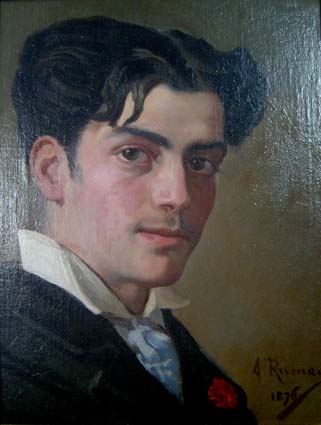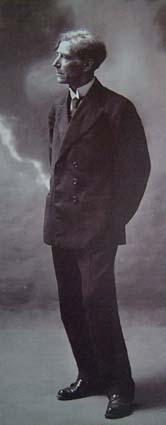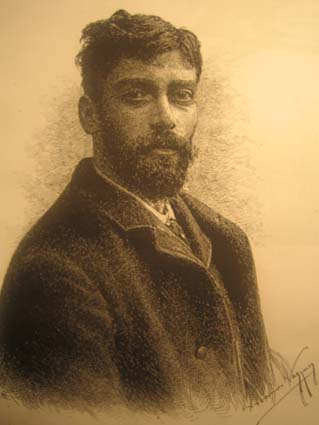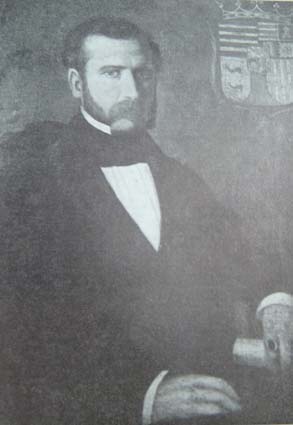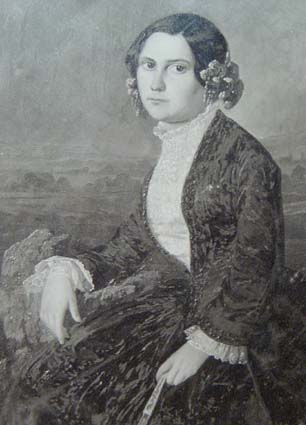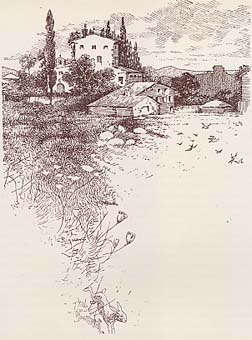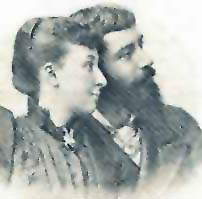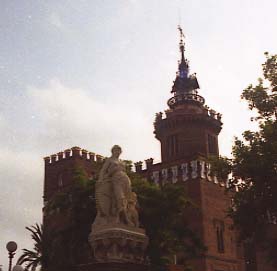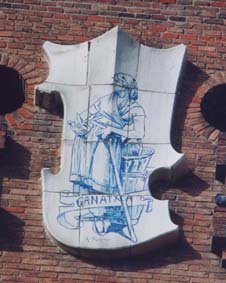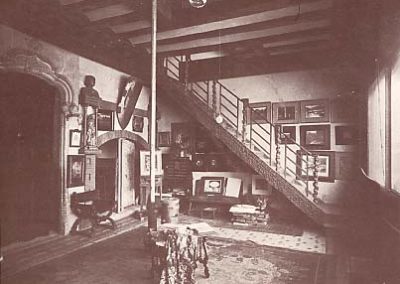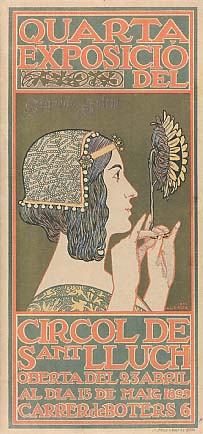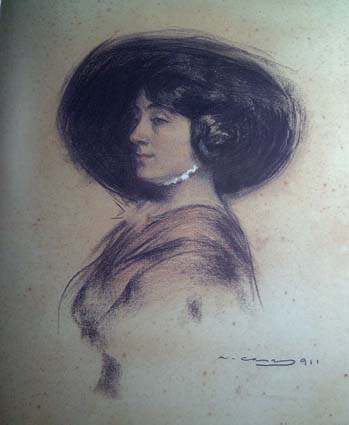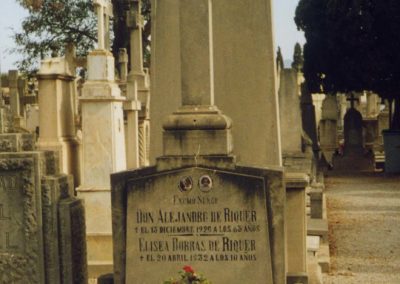Alexandre de Riquer i Ynglada (1856-1920)
Biography
Birth and early years:
Alexandre de Riquer was born in Calaf in the region of La Segarra on May 3, 1856. His father, Marti de Riquer, Marquis of Benavent – a typical example of the country’s conservative nobility – and his mother, Elisea Ynglada, saw their fortunes decline for political reasons.
Alexandre de Riquer is one of the most important and multi-faceted artists of the Catalan Art Nouveau. He undertook his first studies in the Jesuit School of Manresa (1864-1867).
Consequences of the Carlist Wars:
Because of political circumstances deriving from the defeat of the Carlists, Alexandre’s father, a supporter of the king Don Carlos, was forced into exile in Beziers in Provence, where Alexandre enrolled in the school of the Immaculate Conception from 1869 to 1871.
In Beziers, he revealed his first artistic sensibilities (inherited from his mother) and painted his first oils.
After a brief intervention in the Carlist War of 1872, he returned to Toulouse, France and took courses at the School of Fine Arts from 1873 to 1874. There, Riquer painted his first portraits.
Early activities:
In April 1874, Riquer was able to return to Barcelona, where he enrolled in the Llotja School of Fine Arts and became a student of Tomàs Padró, Claudi Lorenzale, and Antoni Caba. His literary vocation began during this period, the first manifestation of which is found in his poems Notes from the Soul.
In 1876, at the age of twenty, he began his first work as an illustrator and lithographic draftsman. His friendship with Ape?les Mestres introduced him into the world of publishing. Riquer collaborated with him in his work witThe father of Riquer (at the rigth of the image) with the pretender to the spanish Crown Charles the VII.h graphic illustrations. Thanks to this first contact, his circle of friends widened to include other artists such as the Arteaga brothers, Joaquim Bartrina, Pompeu Gener, Enric Obiols, Simó Gómez, and others.
He travelled to Rome in 1879 to complete his studies in fine arts, visiting in addition Pisa, Florence, Genoa, Milan, and Venice. Later on, he visited Paris and London, in the latter of which he became involved with the Arts and Crafts and Aesthetic movements on whose foundations he would base his own style.
Economic difficulties put a strain on his creative activity such that in 1880 he concentrated on his excellent illustrations for “Art and Letters”, directed by Lluís Domènech i Montaner. A pre-modernist aesthetic is found in this series, and the influence of Ape?les Mestres is evident together with certain aspects of the Neo-Gothic style following Violet-le-Duc.
His jewelry design designs for the Masriera brothers belong to this period, as do his designs for interior decorations, furniture, invitation stationery for social events, Japanese-style designs, etc.
In 1882 he opened a workshop in a loft above the Pastisseria Mallorquina on Barcelona’s Petritxol Street.
First marriage and early adulthood:
In 1885, Riquer married Dolors Palau Gonzalez de Quijano (Lolita), daughter of a cultured and distinguished family. Jacint Verdaguer blessed the marriage, and Àngel Guimerà and Francesc Matheu were the best men. Nine children resulted from this marriage, but three died in infancy.
For the World’s Fair of 1888 in Barcelona, Riquer collaborated with Lluís Domènech i Montaner, completing the interior decoration of the International Hotel (demolished after the Fair) and the design for the exterior mosaic motifs on the Castle of the Three Dragons. Also from this period is his design for a Neo-Gothic fireplace Gaudí completed for the Palau Güell.
The World’s Fair of 1889 in Paris provided an occasion for Riquer to fix his attention on the Pre-Raphaelites and the Symbolist movement, which gave rise to a renovation of his style that Raimon Casellas termed “mystic-pastoral”. This renovation is visible in his paintings Entre lliris (1890), Divina Pastora (1893), and Anunciació (1893).
In 1892, he founded a cabinet making workshop with his cousin Manel Riquer at 38 Pau Claris Street in Barcelona.
Contacts in other European countries:
During a trip to London in 1894, Riquer found himself in an artistic atmosphere that corresponded to his artistic desires and aspirations; the Pre-Raphaelites (Burne-Alexandre de Riquer and his first wife Dolors PalauJones especially) along with William Morris and the Arts and Crafts movement offered him, besides an updated medievalism, artistic statements that allowed him to shift his work toward a more stylized and highly sophisticated model.
In 1899, Riquer’s wife Lolita died, which threw him into a profound melancholy and left him with the obligation of caring for their young children.
He returned to London in 1906 and was put in charge of the English section of the Fine Arts Exposition to be held in Barcelona in 1907, which confirms the influence and contacts he had made in England.
His assimilation into the aesthetic criteria of Arts and Crafts ran parallel to a diversification of his interests related to art and different artistic techniques, not only in the sense of artistic and artisanal production, but also in a vision that permitted him to unite aesthetic refinement with industrial production. In this manner, the modern means of artistic reproduction – posters, bookplates, illustrations, and engravings – would become his favorite pursuits.
Particularly in the field of bookplates, Riquer completed an enormous undertaking with distinct phases. His production in this field between 1880 and 1903 was collected in the book Ex-libris d’Alexandre de Riquer published in 1903 almost simultaneously in Barcelona, London, and Leipzig. This book was financed by Count Leiningen-Westerburg, which indicates the renown Riquer’s bookplate work had in his own time across Europe. Miquel Utrillo wrote the book’s prologue.
Politics and religion:
In the realm of politics, as could be assumed from his early and energetic support for Carlism, Riquer always maintained a firm Catalanist position, socially conservative and profoundly religious. Under the influence of Domènech i Montaner he became a member of the “Lliga de Catalunya” political conservative Catalans party.
Because of his profound religious beliefs, he became associated with the “Artistic Circle of St. Luke” as soon as one of its founders – Joan Llimona – suggested it to him and participated in its biannual exhibitions. This important center of the diffusion of the Catholic moral tradition in art is still active today.
Riquer, the most multi-faceted artist of the Catalan Art Nouveau:
In 1896, Riquer created the first poster of the Catalan Art Nouveau for the Exposition of Arts and Industries sponsored by the Barcelona City Council. Later, between 1896 and 1902, he created another twenty-odd posters.
Riquer developed from 1880 important decorative works, thus offering the Art Nouveau a decisive contribution in this field as he had in others.
Riquer dedicated considerable energy to decorative painting and the design of interior decoration, often in collaboration with other artists and artisans such as Gaspar Homar i Granell, incorporating elements of refined design in wood, metal, enamel, and other materials. He also produced mosaic designs for the Escofet company.
Other fields in which Riquer’s designs achieved wide renown, in addition to those mentioned above, were in the design of standards and banners for cultural and political entities, furniture designs, and decorative elements as diverse as lamps, candelabras, artistic glasswork, and card games for the Comas and Guarro companies.
Everywhere he lived, Riquer developed an intense relationship with artists and cultural groups. Beyond those previously mentioned, Riquer was associated with the “Quatre Gats” group whose members included Rusiñol, Casas, Puig i Cadafalch, and other well-known artists. In Terrassa, he met the painter Joaquim Vancells. In Ciutat de Mallorca, he developed relationships with artists and individuals linked to cultural endeavors.
Master of the applied arts, Riquer showed multi-faceted skills and developed intense artistic activities in the widest of fields. He was a painter, decorator, draftsman, and writer (more specifically a poet) in addition to engaging in applied arts such as cabinet making, stained glass, and wrought iron designs for which he was considered not only one of the most important authors of the Catalan Art Nouveau, but also the best graphic designer of that era.
Riquer founded a cabinet making workshop, designed furniture – receiving for his creations in this field the gold medal at the World’s Fair in Chicago – glassware, ironwork, etc., and founded a school for graphic design, from which came outstanding posters and bookplates. He illustrated numerous books and magazines.
His enormous prestige is reflected in the words of his friend Eugeni d’Ors i Rovira, who acknowledged Riquer’s enormously important artistic contribution. He said: “The whole country owes Riquer respect and esteem because he has been one of the most highly-prized men. An entire generation has received, from his freely-given instruction, the news and documents of the most modern art. The workshop behind the cathedral, with its collection of beautiful things, has been for many years our School, our only School, generously open to youthful curiosities and enthusiasms. Just as we call Maragall “the essential teacher of the Art of poetry” so should we call Riquer our “essential professor of Art Nouveau”. For this we all owe him our deepest gratitude. I am pleased today to pay him public homage” (Eugeni d’Ors, Glosari, February 1911).
Artistic evolution:
Eliseu Trenc, the most important scholar of Alexandre de Riquer, has divided his artistic evolution into three distinct periods:
• (1880-1894) a first period linked to Aestheticism, also called pre-Modernism, based in an eclectic aesthetic in which Realist and traditional elements are blended.
• (1894-1906) a second period solidly grounded in Art Nouveau that represents the apex of his work and coincides with the period of widest distribution and success in this style.
• (1907-1920) a final period that Trenc defines as “Pantheism” which lasted until Riquer’s death in 1920.
Second marriage:
In 1911 in Oloron Sainte Marie, France, Riquer married the French writer Marguerite Laborde, known by her pen name Andreé Bearn, with whom he would have unstable relations due to problems with their children.
With Marguerite he travelled extensively through Castella, Eivissa, Andalusia, and Mallorca looking for inspiration for his artistic work that then centered almost exclusively on painting, particularly landscapes.
In this period, Riquer put on a number of individual and collaborative exhibitions in various cities, most notably those in Barcelona at the Saló Reig (1914), “El Fayans Català” (1915), in the Sala Parés (1915), and in Prats-Fatjó (1918).
The final years:
In 1919, the “Equestrian Circle” of Barcelona commissioned him to decorate a luxurious bound volume in homage to one of its presidents; Riquer was unable to finish it before his death, and the designer Saurí Sires completed it.
In the catalogues for his exhibitions of 1920, the artist published a summary of his aesthetic concepts which also served as his literary testament, under the title “Credo”.
An avid collector and bibliophile, Riquer had a collection of wrought iron and glass objects of great historic significance that served as the base for Santiago Rusiñol’s – who bought them off Riquer – collection at Cau Ferrat in Sitges.
His collaboration with the magazine Luz, of which he was the founder, was governed by his desire to find an equilibrium between different currents within Art Nouveau, especially between conservatives like the brothers Joan and Josep Llimona represented by the “Artistic Circle of St. Luke” and the more radical innovators of the Sitges group like Rusiñol, Casas, Utrillo, and Casellas.
In 1900 he founded and served as artistic director of the magazine Joventut. As a writer, Alexandre de Riquer, together with Santiago Rusiñol and Adrià Gual, made clear his interest in exploring the potential of symbolism in Catalan language.
He died in Ciutat de Mallorca on November 18, 1920.
Thinking of his early childhood in Bassols, his first love, in the nature of his country that became his final passion, on his deathbed Riquer dedicated this poem, “Credo”, to Ciutat de Mallorca. It serves as a resume of his artistic and essential philosophy.
CREDO:
Jo crec en los colors, en que los colors canten,
ab l’esplendor dels cadmiums brillants d’un bell mitj-dia:
me subjuguen les formes sorpreses y m’encanten
les transparencies tenues com vaga melodia
o el sol de Juny qu’esclata armonic i vibrant:
en ell, atmiro a Deu, atmiro la Natura
y un amedller florit, un’admosfera pura
me’l fan sentir mes bo, me’l fan trobar mes gran.
Jo visc cara a la llum com fan els girassols
y crec en mi mateix, crec en l’Art expansiu
que calma la mev’ansia fentlo per mi tan sols,
perque han florit los prats, perque som al istiu,
perque tot fa remor, tot germina, tot viu;
perque y han verts riquissims endalt de la pineda
y apareixen intimes les ombres misterioses
ahont viuen les fades de formes voluptuoses.
Jo crec perque’l parral, la prada o la roureda
son tendres, son hermoses y fines de color;
jo crec perque una rama s’encen com un llum d’or
perque vibra en lo cingle la roca assoleyada,
perque entr’els blats tendrals floreixen les roselles,
perquè sirisa’l mar del sol de la vesprada,
perque l’ombra del bosc nos guarda meravelles
y es profon la cala y es verda l’onada.
Crec en la Veritat de plastica armonia,
en respirable espay distancies y llum,
en lo sublim encant de pau que te un bell dia
i en la vida qu’es Bellesa, en l’Art qu’es son perfum.
I believe in colors, that colors sing
With the splendor of the brilliant yellows of a beautiful mid-day,
Surprising forms conquer me and tenuous transparencies
Enchant me like a vague melody
Or the June sun that bursts harmonic and vibrant;
In it, I admire God, I admire Nature
And a flowering almond tree, a pure atmosphere
Heighten the sensation, make me feel larger.
I live with my face to the light as the sunflowers do
And I believe in myself, I believe in expansive Art
That calms my anguish, making it for me alone,
Because the meadows have bloomed, because it is summer,
Because everything murmurs, everything grows, everything lives;
Because there are rich greens high up in the pine grove
And the mysterious shadows seem intimate
Where the voluptuous fairies live.
I believe because the trellis, the meadow, the oak grove
Are tender, are beautiful and sharply colored;
I believe because a branch catches fire with golden light
Because the sun-beaten rock on the cliff trembles
Because the poppies flourish among the tender wheat,
Because the sea turns violet in the evening sun,
Because the shade of the forest holds marvels for us
Because the creek is deep and the wave is green.
I believe in the Truth of plastic harmony
In breathable space, distances and light
In the sublime spell of peace cast by a beautiful day
And in the life that is Beauty, its perfume that is Art.
Images
Row 1
-Riquer portrait at 21
-A young Riquer, by Nicanor Vazquez
-Riquer, adulthood portrait
-The father of Alexandre de Riquer, Martí de Riquer, Marquis of Benavent
Row 2
-Elisea Ynglada the mother of Alexandre de Riquer
-The father of Riquer (at the rigth of the image) with the pretender to the spanish Crown Charles the VII
-The familiar house in Bassols (near Calaf) the place of the Riquer childhood
-Alexandre de Riquer and his first wife Dolors Palau
Row 3
-Domènech i Montaner: A view of the Castell dels tres dragons (at present Zoologic Museum) in the Ciutadella Park in Barcelona
-Alexandre de Riquer: Ceramic Coat of arms “Garnatxa” at the “Castell dels tres dragons” in the Ciutadella Park in Barcelona
-Riquer: Poster of the Fourth Exhibition of the “Cercle artístic de Sant Lluc”
-House-Workshop of Alexandre de Riquer in Freneria Street of Barcelona
Row 4
-Portrait of Marguerite Laborde – Andrée Bearn – 2nd. wife of A. de Riquer by Ramon Casas
-Burial of Alexandre de Riquer at the Cimetery of Ciutat de Mallorca
Specific Bibliography |
|||
| Title | Author | Published by | Ayear |
| El Círculo del Liceo (125 aniversario 1847-1972) | Bassegoda i Nonell, Joan | 1973 | |
| Modernismo en Cataluña | Bassegoda, J. y otros autores | Editorial Nuevo Arte Thor | 1976 |
| Alexandre de Riquer y sus diseños para textiles (Datatèxtil nº 9) | Casamartina i Parassols, Josep | Centre de Documentació i Museu Tèxtil de Terrassa | 2003 |
| Els pre-rafaelites a Catalunya | Cerdà i Surroca, M. Angela | Curial | 1981 |
| Ex-libris y exlibristas | Esteve Botey, Francisco | Editorial Aguilar | 1949 |
| El diseño Art Nouveau | Fanelli, Giovanni | Editorial Gustau Gili, SA | 1982 |
| La crisi del modernisme artístic | Fontbona, Francesc | Curial | 1975 |
| Evolució de l’ex-librisme a Catalunya | Fontbona, Francesc | Caixa de Barcelona | 1980 |
| Alexandre de Riquer. L’Home, L’Artista, El Poeta | Various authors/Auteurs divers/Varios autores/Varis autors | Comissió organitzadora de l’Homenatge a A. de Riquer | 1977 |
| Gran Enciclopèdia Catalana Vol 12 | Various authors/Auteurs divers/Varios autores/Varis autors | Enciclopèdia Catalana, SA | 1978 |
| Les Maîtres de l’affiche | Various authors/Auteurs divers/Varios autores/Varis autors | Imprimerie Chaix | 1900 |
| El arte modernista en Barcelona | Ràfols, J. F. | Dalmau | 1943 |
| Modernismo y modernistas | Ràfols, J. F. | Destino | 1949 |
| Diccionario Biográfico de artistas de Cataluña | Ràfols, J. F. | Editorial Millà | 1953 |
| Les arts gràfiques de l’època modernista a Barcelona | Trenc Ballester, Eliseu | Gremi d’Industries Grafiques | 1977 |
| Las artes gráficas de la época modernista en Barcelona | Trenc Ballester, Eliseu | Grafos, SA |
1977 |
| Alexandre de Riquer | Trenc Ballester, Eliseu | Lunwerg | |
| Alexandre de Riquer (1856-1920) The British Connection in Catalan Modernisme | Trenc Ballester, Eliseu & Yates, Alan | The Anglo-Catalan Society | 1988 |
| El primer modernismo literario catalán y sus fundamentos ideológicos | Valentí, Eduard | Ariel | 1973 |
| Alexandre de Riquer i l’ex-librisme | Yebra, Joan Lluís | Universitat de Barcelona, Servei d’informació i publicacions | |
Catalan Art Nouveau Artists and Craftsmen
CERAMICS:ARCHITECTURAL: Joan Alós i Peris Lluís Brú i Salelles Lluís Domènech i Montaner Antoni Maria Gallissà i Soqué Adrià Gual Hipòlit Monseny Germans Oliva Josep Pascó Pujol i Bausis Francesc Quer i Selvas Alexandre de Riquer i Ynglada Sebastià Ribó.
ARTISTIC:Serra Fité DECORATION: Joan Busquets Gaspar Homar Alexandre de Riquer i Ynglada Francesc Vidal.
WROUGHT IRON AND BRASS: Masriera i Campins
FURNITURE AND JOINERS: Joan Busquets i Jané Antoni Maria Gallissà i Soqué Antoni Gaudí i Cornet Gaspar Homar Josep Maria Jujol Lluís Domènech i Montaner Alexandre de Riquer i Ynglada Francesc Vidal i Jevellí STAINED GLASS: Eudald Amigó Alexandre de Riquer i Ynglada
GRAPHIC DESIGN: Ramon Casas Apel·les Mestres Alexandre de Riquer i Ynglada
JEWELLERY: Eusebi Arnau i Mascort Cabot Carreras Lluís Domènech i Montaner Pau Gargallo i Catalán Josep Maria Jujol Germans Masriera Dionís Renart Alexandre de Riquer i Ynglada.
FASHION: Maria Molist
MOSAIC:Lluís Brú i Salelles Germans Oliva Jeroni Granell Mario Maragliano J. Romeu Escofet.
TEXTILE: Antoni Maria Gallissà Josep Puig i Cadafalch Alexandre de Riquer i Ynglada.

